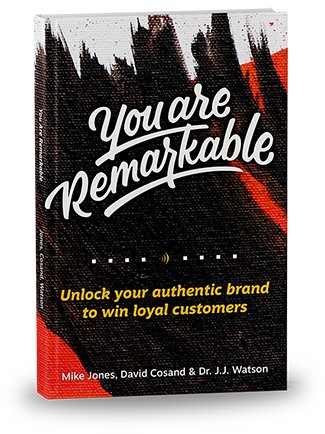Podcast: Play in new window | Download
Subscribe: RSS
Here’s a riddle…although if you’ve been reading or listening recently, it’s more of a review question.
What do slick, wildly successful brands like Salesforce, Nike, and Apple have in common with England’s historic royal families? Aside from hype, hefty name recognition, sky-high valuations that might compare to the Windsor family’s personal fortune, what’s the common thread?
Give up?
From a brand-builder’s perspective, there’s a right answer—they’re all distinguished, organizational, or ‘household’ brands that stamp their values, history, and reputation on every product.
Or in the case of the Windsors, every family member.
When we think about branding for individual products versus branding for organizations, household brands present one kind of overlap.
Usually, it’s the good kind.
Whether they’re putting out a new pair of basketball shoes, a line of kids’ athletic shorts, or an app that can track your biometrics while you work out, all of Nike’s products are clearly Nike. Though varied, built for different purposes, and even aimed at different audiences, each product reflects Nike’s core values. Those shoes, sorts, and app all exude its mantra of just do it, and carry that same reputation for stylish, athletic excellence. Each has the swoosh logo in a place where you can see it.
In other words, that strong, overarching brand carries a lot of weight and communicates a distinct identity. But while they all get a lift from that household brand, all of those individual products need to maintain trust and consistency.
Of course, Nike, Apple, and even Disney are not indestructible.
If a company with a high-flying reputation puts out one bad product, and then another…soon enough the entire brand will suffer.
Moving on From Product Branding
Last month, I talked all about product branding, and how making really amazing products (or, if you’re a business to business company, offering really amazing services) is a prerequisite, but not enough. Without a cohesive brand expression, marketing, and a strategy for gaining the trust and attention of those who might need that product, or service, chances are few people will know about it.
To that end, thoughtful product branding strategy hinges on the audience.
Knowing who your audience is and what relationship you’re building with them by way of your service is the starting point—and for many successful companies (Jeep, for one, comes to mind), it’s one way to build a widely recognized organizational brand.
People get to know that overall brand, and in the future, they return to them, because of their relationship with a product or service they really love. The association of the product transfers over to the household brand, and hopefully to more products or services that household brand might offer.
While this makes sense if you’re building outward for a product, or a service, there’s another, and I’d argue, a more advantageous way to approach branding for an organization.
Branding Your Organization Starts With…Your Organization.
No, I actually mean that.
While it might sound somewhat corny or on the nose, please bear with me:
Rather than starting with the audience (as you might with product branding…or as you’d probably have to if your whole brand is wrapped up in one product), start with yourself.
I’m not saying your audience, your customers, or the corner of the world that you’ll be interacting with day in, day out is irrelevant.
Don’t throw everyone else overboard while you go on some pilgrimage to another dimension.
Instead, do yourself the courtesy of realizing you, your team, and your entire organization is remarkable. From there, start digging…and just like you’d examine your audience, their needs, their history, their location, their purpose, their unique traits, values, likes, and dislikes as if you were marketing a product, examine those things in your own organization.
Take the time, and possibly take the whole operation through a discovery workshop, and come to a clear understanding of your history, location, purpose, unique traits, values, likes and dislikes…and so forth.
While audience may be the biggest consideration in product branding, organizational branding starts closer to the famous line from Shakespeare’s Hamlet: ‘To thine own self be true.’
True that, Polonius.
Building a strong, organizational brand that will lend coherence and name recognition to your products while relaying your values and purpose starts with building on your own true identity. While I could (and while I have in previous articles) run through all the pitfalls of building a brand on anything other than one’s truthful, authentic, purpose-driven identity, the short and quick summary is that brands built on truthful identities resonate with people.
And at the organizational level, overarching brand identities that resonate lend that authenticity and clarity to every product or service that reaches someone.
Getting Down to B2B Branding
Yes, let’s do that.
After all, product and organization branding for business to business (rather than business to consumer) companies comes with its own particular flavor. Even if principles—like building on a truthful identity, or strong organizational brands giving a lift to that brand’s individual products—carry over, the specifics are worth looking at.
Assuming you’ve done the hard work of building an authentic brand identity for your organization (with all the soul searching and elbow grease that goes with that), there’s a number of things to know about branding an organization based on services.
Again, and to circle back to some aspects of product branding, this is where your company’s identity, values, and truthfully crafted brand expression meet and build relationships with an audience.
In the B2B sector, customers need services for a variety of reasons.
If you think of an accounting firm, for example, it’s clear that people hire them in different capacities, to different degrees, and for a number of reasons.
A small business, or even an individual—say, a freelancing graphic designer—might need tax filings come February. So they’ll hire an accounting firm to complete those filings.
But a larger business, or a family with considerable wealth to manage might hire the same accounting firm that does their taxes to track their day-to-day finances and consult accordingly.
The conversation might even sound like: ‘Hey, our bookkeeper is just not cutting it. Can you do some bookkeeping for us and fine tune the process?”
And if that same business is growing, merging, or moving across state lines, the question becomes: ‘can you help us with state tax and local tax issues?’
And so on.
Your Brand Name Matters
We begin to see why strong organizational B2B brands (again, Salesforce comes to mind), offer different services, or even bundle services into different packages. When a new situation opens up an opportunity to help someone with other problems…each solution stands ready. And the stamp of the household brand offering that convenient service becomes more trustworthy.
While each service has its own identity, audience, and purpose, it stands within the larger brand identity—and customers can find them, identify them, and understand what they’re getting because they have some familiarity with the organization brand.
One that’s built out those services from a clear, truthful identity, but tailored them to reach and help people in different ways.
Putting It All Together
Like the old chicken and the egg analogy, it’s hard to think of product branding and organization branding as existing in the abstract.
Organizations exist to offer services and products to a distinct audience…but those services and products would not exist without the underlying organization and its purpose, values, and identity.
When the rubber meets the road, organizational brands who know themselves (that is, they present themselves truthfully and their products and services are in sync with that true identity) will present themselves and their services to the right customer in a targeted way.
If they’re an accounting firm specializing in corporate finance, chances are, they’ll know how the CEO wants to be approached about a solution to tax issues. Or if they’re in the business of helping car dealerships, they’ll know what’s on the mind of the guy managing the lot…and knowing his needs, they’ll approach him with the right solution.
Brands that offer different solutions will know that those solutions need to feel like they’re part of the same family, like they belong together.
That brand’s tone, voice, brand expression, and marketing strategy will all cohere under the household’s purpose and values.
And if they’re successful, people will see it and hear it a mile away.
What About that Newest Product?
Done well and with an eye on both a product’s audience and how that product carries the household brand, a strong organizational brand helps people fit what they see into a larger story. Values, history, and a purpose built on authentic identity all pay dividends when a customer goes: “Yeah, that makes sense. I understand why you guys offer that.”
One last warning would be keeping an eye on new, flashy services or products that companies hope will take off. The temptation is to spin a new product or service as the latest, greatest thing…but how will that newest thing feed your larger brand and drive it forward?
If it’s wildly different and confusing for your audience, or if it has all the success of a tissue fire, how will that affect people’s perception of your other products?
Of your brand as a whole?
Building and maintaining a solid organizational brand is no small task. And while most companies offer new products or services at some point in their history, that shouldn’t be done in a way that detracts from other services or products the household brand might offer.
There’s even times when launching a wildly new product means considering a new brand to fit that product…or even rebranding.
But outside of those cases, new products and services should cohere with everything else, and they should strengthen your brand’s image in your corner of the world.
Remember What’s Remarkable
Here’s a few concluding thoughts to wrap up product versus organizational branding.
-It’s important to understand how branding a product differs from branding an entire organization.
-When a product fits within the organizational brand well and resonates with customers, you can build a strong relationship with them.
-Trust and a relationship can help you house similar products and services within your organizational brand…but only insofar as they represent your brand well and make good on its promises.
-While organization branding starts with yourself…always consider your audience—what they need, how they want to be approached, and the relationship they have with you through your services, products, and brand expression.
That’s all for this month.
For more resources on discovering your remarkable identity and building a brand that resonates, give the Resound team a shout. Or check out my book ‘You are Remarkable’, available on Amazon.com.
Until next time, happy branding.



